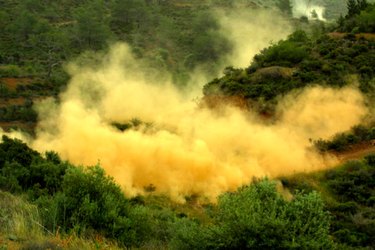
Forest fires can be disastrous. They can spread quickly and dangerously through large territories. Firefighters work hard to put out these fires, but, as the ThinkQuest library states, "There are obviously no fire hydrants in a forest, it is more difficult to fight wildfires. Tanker trucks can't be driven in because of all the trees and lack of roads. The trees, brush, and leaves provide ideal fuel for the fire because they are so flammable." Therefore, putting out forest fires is trickier than it seems. Special procedures (and chemicals) are required.
Putting Out Small Fires
Video of the Day
Forest fires can be put out using special tools, including a Pulaski (a combination ax and hoe used to dig a fire line,) smokejumpers (firefighters who specialize in battling big blazes) and hotshots (small teams of expert firefighters who deal in especially dangerous situations).
Video of the Day
Putting Out a Big Fire
Large wildfires can be put out using special chemicals dropped from helicopters to smother the flames. One of these is a pink fire-retardant chemical commonly called "sky Jello-O," according to the ThinkQuest Library. Sky Jell-O is made up of 85 percent water, 10 percent fertilizers, specifically ammonia phosphate and sulfate ions, and 5 percent other materials, according to UCSB Science Line. Like other flame retardants, it works by stopping chemical reactions in the fire.
Prevention
There are a few things a person can do to avoid forest fires, such as extinguishing cigarettes properly, avoiding the use of open fires, using barbecues in safe areas and reporting any kind of fire you see as soon as possible, among others.
Causes
Fires require fuel, oxygen and heat. In a forest, the fuel is easily provided by trees and leaves. The oxygen is always there and the heat can be provided by the sun. For example: a misplaced glass or plastic bottle can overheat with the sunlight. Once it is too hot, it can ignite the grass, leaves or bushes. And before you know it, the fire is apreading throughout the forest. Other causes of forest fires include cigarettes, barbecues, trash, flammable liquids and matches.